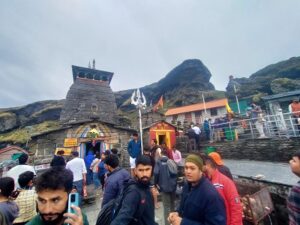While many devotees flock to the well-known Shiva temples in India during Shivratri. There are several off-the-grid Shiva temples that offer an equally enriching, yet less commercialized, experience. In this post, we will cover the 12 off-the-grid almost hidden Shiva temples which you also plan to visit this Shivaratri.
If you’re looking to make your Shivratri journey more unique and serene, consider exploring these 12 hidden Shiva Temples in India. These are based in serene and rich locations which also offer you an escape from the daily hustle and bustle.
These lesser-known Shiva temples and their hidden locations offer spiritual growth and an opportunity to escape the crowds.
12 Off-the-Grid Hidden Shiva Temples To Go This Shivaratri
1. Tungnath Temple, Uttarakhand

Tungnath Temple, nestled in the Garhwal Himalayas at an altitude of 3,680 meters, is the highest Shiva temple in the world. While Kedarnath is famous for being a high-altitude temple, Tungnath offers an equally awe-inspiring and tranquil experience with fewer crowds. The trek to Tungnath passes through scenic meadows and dense forests, making it an unforgettable adventure.
Celebrating Shivratri here is a rare experience, the mountain winds whisper ancient chants, and the temple remains surrounded by snow-capped peaks, offering a deep connection to the divine. It’s an ideal destination for those looking to combine spirituality with adventure.
2. Bhimashankar Temple, Maharashtra
Located in the dense forests of the Sahyadri mountain range, Bhimashankar is one of the twelve Jyotirlingas, yet it remains relatively less crowded compared to other pilgrimage sites. Surrounded by lush greenery and wildlife, the temple is not just a place of devotion, but also a haven for nature lovers.
The peaceful ambience and the sound of distant waterfalls provide the perfect setting for Shivratri celebrations. The temple complex, with its ancient architecture, also holds a deep connection to the legend of Bhima, making it an intriguing spot for history and mythology enthusiasts.
3. Ramanathaswamy Temple, Rameswaram
Though Rameswaram is a popular destination for devotees, it’s often overshadowed by temples in the northern and central parts of India. However, the Ramanathaswamy Temple holds unique significance during Shivratri. Located on the serene island of Rameswaram, Tamil Nadu, the temple is known for its sacred 22 wells, each believed to cure a different ailment.
During Shivratri, pilgrims take a holy dip in the temple tanks, while the temple’s stunning architecture and the proximity to the Indian Ocean provide a beautiful, spiritual backdrop for the celebration. Visiting Rameswaram allows you to not only connect with Lord Shiva but also to experience the divine energy of the sea.
4. Vaijnath/Baidyanath Temple, Jharkhand
The Vaijnath Temple, located in the remote forests of Jharkhand, is dedicated to Lord Shiva and is one of the lesser-known Jyotirlingas. Located near the village of Vasukinath, it offers a truly off-the-grid experience for those looking to escape the usual pilgrimage crowds.
The temple is surrounded by dense forests and is accessible by foot, making it an excellent destination for those seeking solitude and spirituality. During Shivratri, the temple becomes a serene place for reflection, with pilgrims enjoying the tranquility of the surrounding wilderness while offering prayers.
5. Chandeshwar Temple, Bihar
Hidden along the banks of the Ganges, the Chandeshwar Temple in Bihar is often overlooked by mainstream pilgrims, making it a peaceful alternative during Shivratri. The temple is dedicated to Lord Shiva in his Chandeshwar form and has historical significance due to its ties to ancient mythologies.
Set against the backdrop of the holy river, the temple exudes an aura of calm and devotion. The festivities during Shivratri are deeply traditional, and the temple’s quiet surroundings make it an ideal spot for reflection and spiritual connection without the rush of larger temples.
6. Madhyameshwar Temple, Uttarakhand
For those seeking a spiritual journey that’s equally about the trek as it is about the destination, Madhyameshwar Temple offers a perfect mix. Located in the Garhwal Himalayas, the temple is not as famous as other Jyotirlingas, but its remote beauty makes it a unique destination for Shivratri pilgrims.
The trek to Madhyameshwar is an arduous one, taking you through dense forests, picturesque meadows, and challenging mountain terrain. But once you reach the temple, the feeling of achievement and connection with the divine is unparalleled. It’s a place where the raw beauty of nature and spirituality meet in perfect harmony.
7. Jambukeswarar Temple, Tamil Nadu
Located in Thiruvanaikaval, Tamil Nadu, Jambukeswarar Temple is dedicated to Lord Shiva in his form of ‘Jambukeswarar,’ where he is worshipped in the element of water. One of the five Pancha Bhoota Stalas, this temple’s unique feature is the underground water flow that symbolizes the element of water, making it an enchanting site during Shivratri.
While not as well-known as temples like Meenakshi in Madurai, this serene spot offers a quieter experience to meditate on the power of water and Lord Shiva’s connection to nature.
8. Kunchikal Falls, Karnataka
Though not a temple per se, the Kunchikal Falls in Karnataka is a stunning natural wonder associated with Lord Shiva. Legend has it that the falls are sacred to Shiva, and locals often visit during Shivratri to pay their respects and offer prayers. The falls are the highest in Karnataka, cascading from a great height into lush greenery, offering a tranquil setting for devotion.
For nature lovers and those looking for an alternative pilgrimage, visiting the Kunchikal Falls during Shivratri provides a rare opportunity to worship amidst the beauty of nature.
9. Kailash Manasarovar (Tibet)
While not in India, this sacred site holds a significant place for devotees of Lord Shiva. Kailash Mansarovar, located in Tibet, is believed to be Lord Shiva’s earthly abode. The journey to this remote place is physically demanding, but it offers a profound spiritual experience. The Mansarovar Lake is particularly revered for its pure waters and spiritual significance.
10. Shivkhori (Jammu and Kashmir)
Shivkhori, located in the Reasi district of Jammu, is a cave shrine dedicated to Lord Shiva. Hidden amidst the mountains, it is known for its natural stalactite formation resembling the “Shiva Lingam.” This site is relatively off-the-beaten-path and offers a mystical experience for those seeking an intimate connection with Lord Shiva on Shivratri.
11. Baijnath Temple (Himachal Pradesh)
Located in the serene Kangra valley, the Baijnath Temple in Himachal Pradesh is one of the lesser-known Shiva temples in India. This beautiful ancient temple dedicated to Lord Shiva is nestled in the midst of lush greenery, offering peace and tranquillity. It is an ideal destination for those seeking solitude during Shivratri.
12. Chidambaram Temple (Tamil Nadu)
Chidambaram, though not completely off the grid, is less crowded compared to other major temples in Tamil Nadu. This ancient temple dedicated to Lord Shiva is famous for its Nataraja (dancing Shiva) form. It is a place where Shiva’s cosmic dance is celebrated with great reverence, and Shivratri is one of the key times for rituals and festivities.
Conclusion
Shivratri is a time to connect with Lord Shiva in a deeply personal way and these lesser-known temples and hidden destinations offer the perfect backdrop for such a journey. Whether it’s trekking to a remote temple in the Himalayas or offering prayers by a quiet river, these off-the-beaten-path spots allow for a more intimate and meaningful spiritual experience.
So, if you’re seeking something different this Shivratri, venture beyond the usual temples and explore the sacred corners of India where you can truly connect with the divine and find peace away from the crowds.
FAQs =》
Q1. Are off-the-grid pilgrimage sites difficult to access?
Ans. Some of these sites can be challenging to reach, requiring long treks, remote transport options or even adventurous hiking routes.
Q2. What are the best times to visit these off-the-grid Shivratri temples?
Ans. The best time to visit is, of course, during Shivratri, as these temples host special ceremonies and events to honour Lord Shiva. However, these places can also be visited during the months leading up to or after Shivratri when the weather is pleasant, and the crowds are fewer.
Q3. Is it safe to visit these remote pilgrimage sites during Shivratri?
Ans. While many of these destinations are safe for devotees, it’s important to prepare well before visiting remote areas. This includes checking the weather, packing appropriately for trekking, and ensuring that you have reliable transportation and accommodations. Travelling with a group or guide is also a good option for added safety.
Q4. Can I find accommodation near these remote temples?
Ans. Accommodation options near off-the-grid temples can be limited. In some cases, basic guesthouses, Dharamshala (pilgrim rest houses) or local homes may offer shelter. It’s recommended to book in advance or carry your own camping gear if you’re heading to very remote locations.
Q5. What should I pack for an off-the-grid Shivratri pilgrimage?
Ans. When visiting these remote sites, pack essentials such as comfortable trekking shoes, warm clothing especially if visiting mountainous areas, basic toiletries, a flashlight or headlamp, a first-aid kit, a water bottle and snacks.
Q6. Can I visit these sites throughout the year or only during Shivratri?
Ans. While Shivratri is the peak time for spiritual gatherings and rituals, many of these temples can be visited throughout the year. However, due to the heightened devotion and religious activities, visiting during Shivratri can offer an especially powerful experience.


